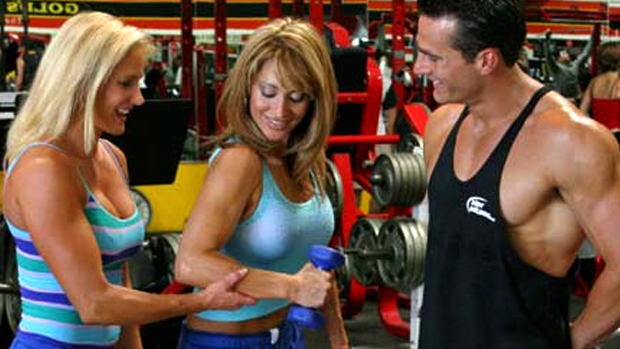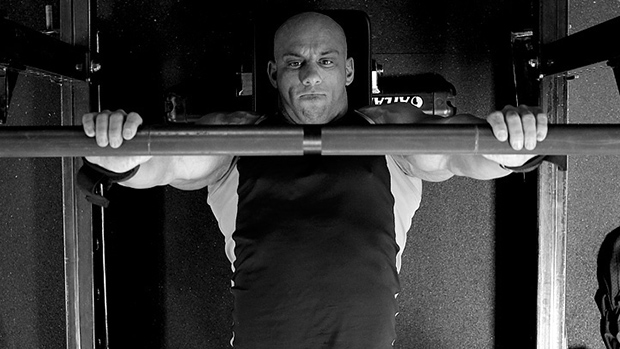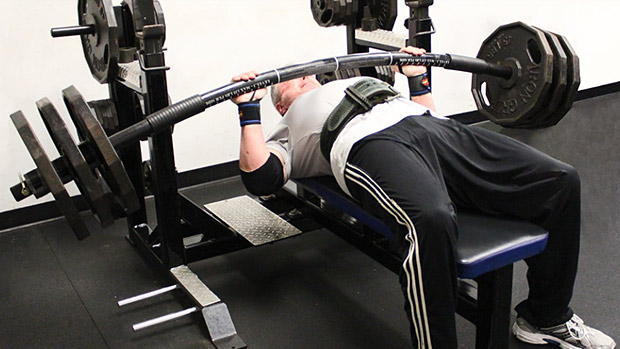If you could only choose one exercise to train your core, it should be the single-arm plank. Here's what the basic move looks like:
Now, if you want to take things up a notch, try these tough variations.
A simple progression of the single-arm plank is to add weight. In the video, NFL linemen Fernando Velasco and Cordy Glenn do this deceptively difficult drill to prepare their bodies for the physical demands of the brutal season.
Notice the subtle form adjustments we make to ensure maximum tension to the core and maintain good spinal alignment. Most will want to cheat the single-arm plank by creating cervical hyper-extension and tilting their heads up. This not only strains the neck, but it places excessive tension on the lumbar spine by causing the hips to sag.
Focus on keeping a tall and elongated neck throughout rather than tilting the head up or down.
This targets rotary stability, anti-extension, shoulder stability, postural alignment, motor control, balance, and overall core strength.
There's no room for error on this movement. It'll expose any weakness or neuromuscular deficiency anywhere in the body. It's also a great way to warm up before crushing heavy weights on compound movements. It's very effective for reinforcing rigid posture and spinal alignment.
Try keeping a straight line from hand to foot with very little rotation in the torso. Start off by having your forearm on the floor and then eventually progress to having your hand on the ground for a real stability challenge. Elevating the feet further increases the difficulty.
This is a difficult but highly effective movement for hitting the entire core, hips, shoulder stabilizers, triceps, chest, lats, and more. Not only are you resisting lumbar and hip extension, which taxes the anterior core and transverse abs, but you're also resisting rotational forces that are more challenging due to the instability of the suspension system.
This move recruits all available stabilizers around the core, hips, and groin, making it one of the most effective core movements for bulletproofing your spine and reducing injury risks to the lumbo-pelvic hip complex.
Adding extra weight directly to the lumbar region (through plates or chains) targets anti-extension muscles around the abdominal region. And if you really want to hurt, elevate your feet.
Adding the stability ball to planks – particularly single-arm variations – is an incredible stimulus to the core. It's one of the most challenging drills you'll ever attempt. Even the slightest lapse in concentration causes you to lose your balance.
Maximally brace every muscle in your body if you want to successfully complete this drill. To make things even more extreme, try adding weight or elevating your feet on a bench.
For this one, use a slide board, Valslide disks, slick surfaces (using a towel or socks), or anything that allows the feet to slide. Just be prepared to brace your core hard or else this one simply won't happen.
- The wider the stance, the easier the single-arm plank, while a narrower stance works the core stabilizers more intensely. Generally, use a stance that's slightly wider than shoulder width.
- Place the non-working arm towards the side of the body without that arm actually touching the outer hip. Supporting the leg with the arm is a subtle form of cheating.
- Focus on squeezing the non-working arm and keeping it tight to activate the lats and shoulder stabilizers of the opposite side via neuromuscular cross-transfer.
- Keep both legs fully straight rather than allowing a slight knee bend. This helps you to keep a tall hip position and hollowed core instead of sagging at the hips.
- Try to stay as tall on the toes as possible.
- Don't squeeze the glutes! This will disengage the hip flexors. The hip flexors play a pivotal role in any plank – they keep the hips from dropping.
- Avoid a crowded and compressed spinal position. And don't allow the shoulders to round or elevate. Maintain a neutral spine by focusing on lengthening out the body while keeping the chest out and hips tall.
- To avoid rotation, keep your torso as square to the floor as possible.
- Once you can complete 30 seconds of a standard single-arm plank at ground height on each side without taking a break, progress the movement by placing weight on your back or elevating your feet.
Aside from function and appearance, the single-arm plank...
- Improves mental and physical conditioning: Besides teaching you Jedi-like focus, your heart rate also goes through the roof. You'll probably feel like you just ran several sprints after just one set. Adding these into a high intensity conditioning routine as part of a larger circuit will boost your strength, stamina, and endurance.
- Gets rid of low back pain: Few exercises involve simultaneous anti-rotation and anti-extension, but the single-arm plank does just that. Master it and watch your back pain fade away.
- Improves upper body strength: You'll be intensely activating nearly every upper body muscle including your chest, lats, triceps, deltoids, and upper back.
- Improves function in the lumbo-pelvic hip complex: If you have trouble with hip, groin, knee, or low back pain, chances are you need to strengthen the muscles around the hips and pelvic floor, along with the core and spinal stabilizers. Single-arm planks will do it, and they even improve sprint speed.
- Increases the intensity of core training: Most standard plank variations are fairly low intensity. But doing one set of single-arm planks for 15 seconds on each side (30 seconds total) will do more for your entire core than just about any exercise. Instead of mindlessly holding planks for several minutes, try a few sets of single-arm planks. You'll save time and your whole body will be smoked.
- Requires no equipment: How many exercises can devastate your entire core, hips, and upper body while using no equipment?
- Improves breathing patterns: Knowing how to control your breathing (i.e., sipping air through a straw) while maintaining heightened levels of spinal rigidity, core tightness, and full body tension is a valuable skill. This is important not only for lifting heavy shit, but for daily living and postural control.
- Teaches you to stay tight: The ability to create full body tension is important for eliminating energy leaks and areas of weakness throughout the kinetic chain. This has a big impact on your ability to transmit force and absorb incoming forces.
- Minimizes cheating and lumbar extension: It's difficult to cheat on single-arm planks. Although it's possible to use slight rotation and twisting, it's nearly impossible to have sagging hips and lumbar extension – you'd collapse.
- Allows for simple regressions and progressions: The single-arm plank is one of the simplest exercises to regress and progress based on your level of strength and function. As a result, you'll have endless options.




